7.2: Classification of Joints
- Page ID
- 63411
- Distinguish between the functional and structural classifications for joints
- Describe the three functional types of joints and give an example of each
- Describe the structural features of fibrous joints and of cartilaginous joints
- Distinguish between a suture, syndesmosis, and gomphosis
- Give an example of each type of fibrous joint and each type of cartilaginous joint
- Distinguish between a synchondrosis and symphysis
A joint, also called an articulation, is any place where adjacent bones or bone and cartilage come together (articulate with each other) to form a connection. Joints are classified both structurally and functionally. Structural classifications of joints take into account whether there is a space (joint cavity) between the bones or whether the gap is fully filled by either dense connective tissue or cartilage. Functional classifications describe the degree of movement available between the bones, ranging from immobile, to slightly mobile, to freely moveable joints.
Structural Classification of Joints
The structural classification of joints is based on whether the articulating surfaces of the adjacent bones are directly connected by fibrous connective tissue or cartilage, or whether the articulating surfaces contact each other within a fluid-filled joint cavity. These differences serve to divide the joints of the body into three structural classifications.
- A fibrous joint is where the adjacent bones are united by dense regular connective tissue.
- At a cartilaginous joint, the bones are joined by hyaline cartilage or fibrocartilage.
- At a synovial joint, the articulating surfaces of the bones are not directly connected, but instead come into contact with each other within a joint cavity that is filled with a lubricating fluid. Synovial joints allow for free movement between the bones and are the most common joints of the body. These three structural classifications will be discussed in further detail in the following sections of this chapter.
Fibrous Joints
At a fibrous joint, the adjacent bones are directly connected to each other by dense regular connective tissue, and thus the bones do not have a joint cavity between them (Figure \(\PageIndex{1}\). The gap between the bones may be narrow or wide. There are three types of fibrous joints. A suture is the narrow fibrous joint found between most bones of the skull. At a syndesmosis joint, the bones are more widely separated but are held together by either a narrow band of fibrous connective tissue called a ligament or a wide sheet of connective tissue called an interosseous membrane. This type of fibrous joint is found between the shaft regions of the long bones in the forearm and in the leg. Lastly, a gomphosis is the narrow fibrous joint between the roots of a tooth and the bony socket in the jaw into which the tooth fits.
Suture
All the bones of the skull, except for the mandible, are joined to each other by a fibrous joint called a suture. The dense regular connective tissue found at a suture (“to bind or sew”) strongly unites the adjacent skull bones and thus helps to protect the brain and form the face. In adults, the skull bones are closely opposed and fibrous connective tissue fills the narrow gap between the bones. The suture is frequently convoluted, forming a tight union that prevents most movement between the bones. (Figure \(\PageIndex{1}\)) Thus, skull sutures are functionally classified as a synarthrosis, although some sutures may allow for slight movements between the cranial bones.
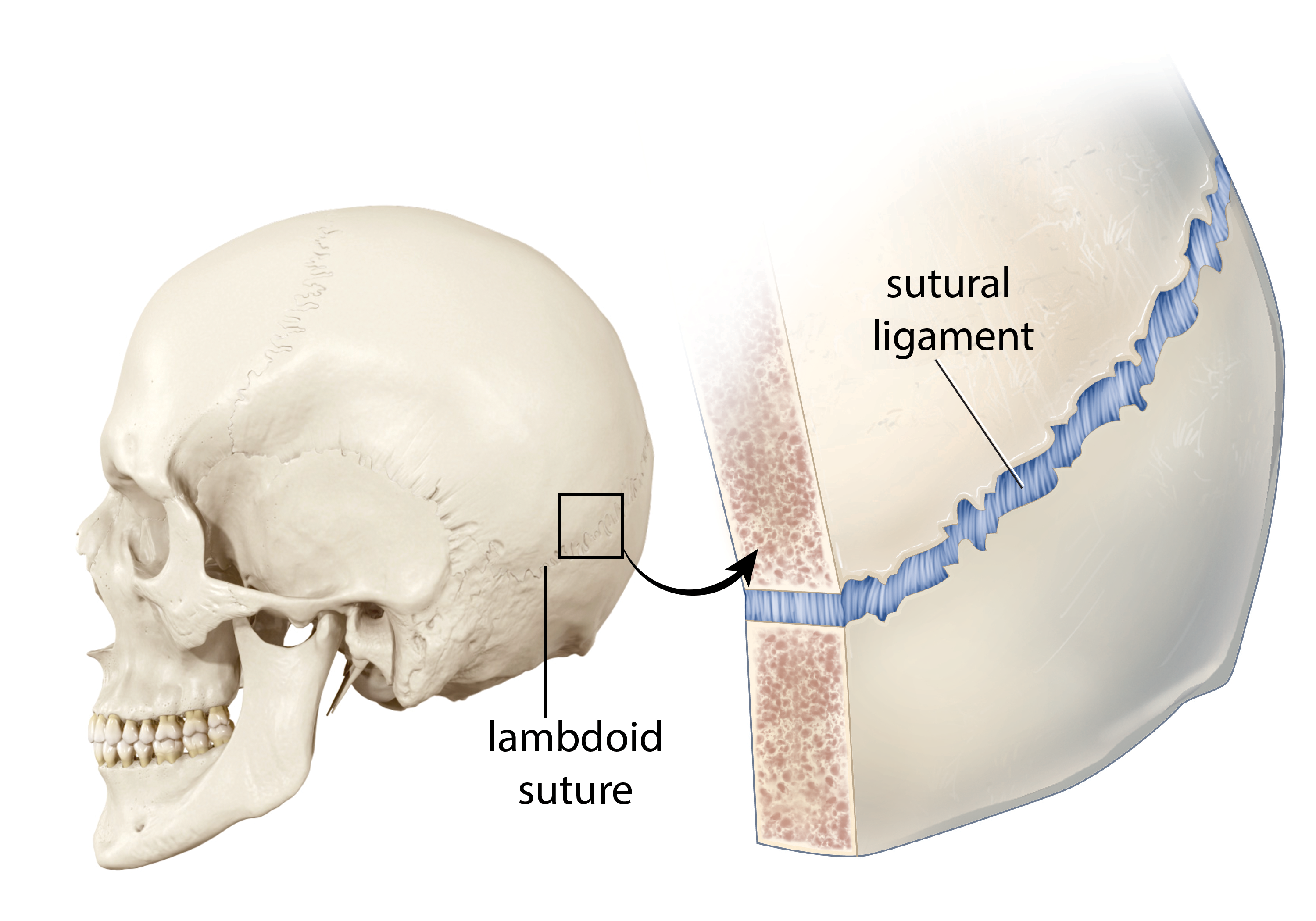
In newborns and infants, the areas of connective tissue between the bones are much wider, especially in those areas on the top and sides of the skull that will become the sagittal, coronal, squamous, and lambdoid sutures. These broad areas of connective tissue are called fontanelles (Figure \(\PageIndex{2}\)). The most prominent fontanelle is the anterior fontanelle, which can be found on top of the skull between the frontal bone and the parietal bones. For some newborns, the anterior fontanelle is visible on the top of the head, and is often called the infant's "soft spot". The posterior fontanelle can be found on the back side of the skull between the parietal bones and occipital bone. On the sides of the skull are two fontanelles, the sphenoidal fontanelle and the mastoid fontanelle. The sphenoidal fontanelle is located toward the anterior of the skull just superior to the sphenoid bone and connects the sphenoid bone, frontal bone, parietal bone, and temporal bone. The mastoid fontanelle, found toward the posterior of the skull, connects that occipital bone, parietal bone, and temporal bone.

During birth, the fontanelles provide flexibility to the skull, allowing the bones to push closer together or to overlap slightly, thus aiding movement of the infant’s head through the birth canal. After birth, these expanded regions of connective tissue allow for rapid growth of the skull and enlargement of the brain. The fontanelles greatly decrease in width during the first year after birth as the skull bones enlarge. When the connective tissue between the adjacent bones is reduced to a narrow layer, these fibrous joints are now called sutures. At some sutures, the connective tissue will ossify and be converted into bone, causing the adjacent bones to fuse to each other. This fusion between bones is called a synostosis (“joined by bone”). Examples of synostosis fusions between cranial bones are found both early and late in life. At the time of birth, the frontal and maxillary bones consist of right and left halves joined together by sutures, which disappear by the eighth year of life as the halves fuse together to form a single bone. Late in life, the sagittal, coronal, and lambdoid sutures of the skull will begin to ossify and fuse, causing the suture line to gradually disappear.
Syndesmosis
A syndesmosis (“fastened with a band”) is a type of fibrous joint in which two parallel bones are united to each other by fibrous connective tissue. The gap between the bones may be narrow, with the bones joined by ligaments, or the gap may be wide and filled in by a broad sheet of connective tissue called an interosseous membrane.
In the forearm, the wide gap between the shaft portions of the radius and ulna bones are strongly united by the antebrachial interosseous membrane (Figure \(\PageIndex{3}\)) . Similarly, in the leg, the shafts of the tibia and fibula are also united by the interosseous membrane. In addition, at the distal tibiofibular joint, the articulating surfaces of the bones lack cartilage and the narrow gap between the bones is anchored by fibrous connective tissue and ligaments on both the anterior and posterior aspects of the joint. Together, the interosseous membrane and these ligaments form the tibiofibular syndesmosis.
The syndesmoses found in the forearm and leg serve to unite parallel bones and prevent their separation. However, a syndesmosis does not prevent all movement between the bones, and thus this type of fibrous joint is functionally classified as an amphiarthrosis. In the leg, the syndesmosis between the tibia and fibula strongly unites the bones, allows for little movement, and firmly locks the talus bone in place between the tibia and fibula at the ankle joint. This provides strength and stability to the leg and ankle, which are important during weight bearing. In the forearm, the interosseous membrane is flexible enough to allow for rotation of the radius bone during forearm movements. Thus in contrast to the stability provided by the tibiofibular syndesmosis, the flexibility of the antebrachial interosseous membrane allows for the much greater mobility of the forearm.
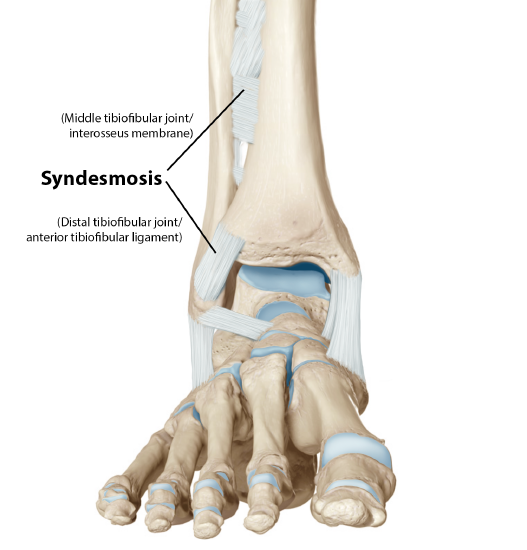
The interosseous membranes of the leg and forearm also provide areas for muscle attachment. Damage to a syndesmotic joint, which usually results from a fracture of the bone with an accompanying tear of the interosseous membrane, will produce pain, loss of stability of the bones, and may damage the muscles attached to the interosseous membrane. If the fracture site is not properly immobilized with a cast or splint, contractile activity by these muscles can cause improper alignment of the broken bones during healing.
Gomphosis
A gomphosis (“fastened with bolts”) is the specialized fibrous joint that anchors the root of a tooth into its bony socket within the maxilla (upper jaw) or mandible (lower jaw) bones of the skull. A gomphosis is also known as a peg-and-socket joint. Spanning between the bony walls of the socket and the root of the tooth are numerous short bands of dense fibrous connective tissue, called the a periodontal ligament (Figure \(\PageIndex{4}\)). Due to the immobility of a gomphosis, this type of joint is functionally classified as a synarthrosis.
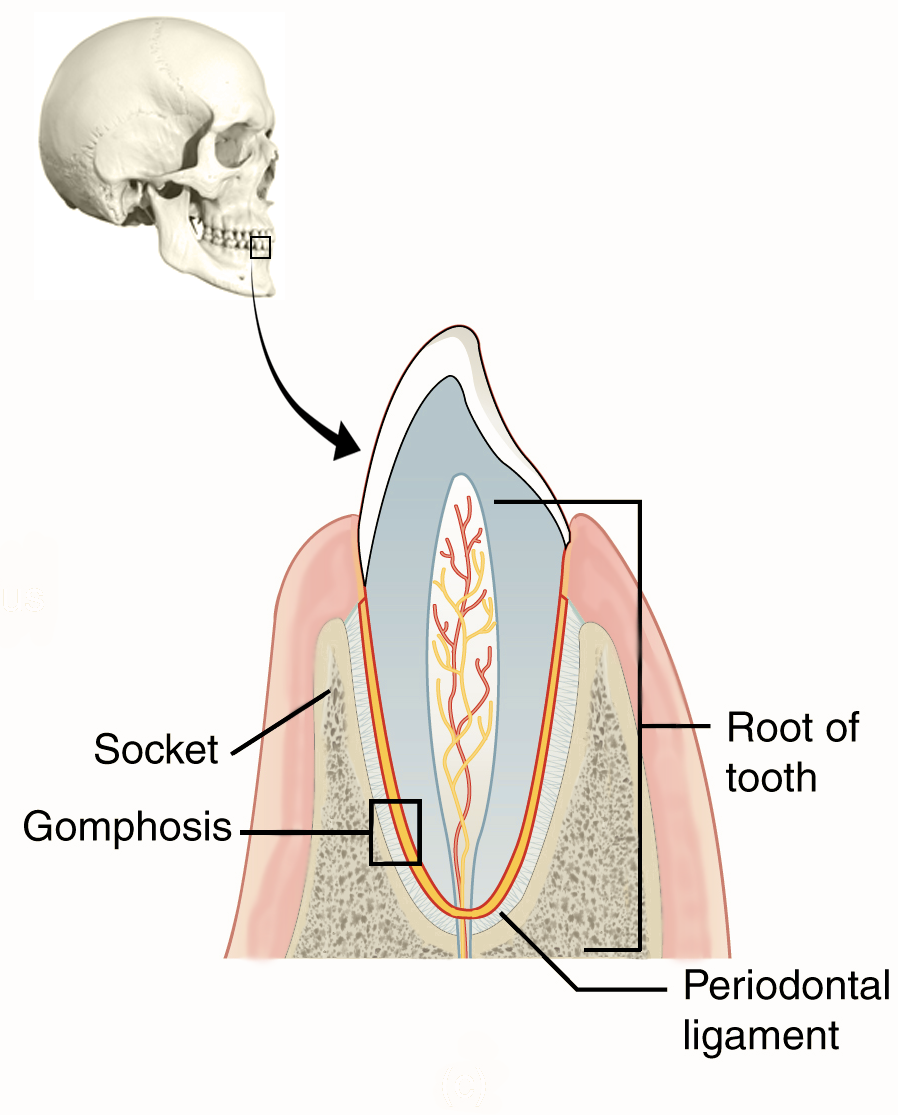
Cartilaginous Joints
As the name indicates, at a cartilaginous joint, the adjacent bones are united by cartilage, a tough but flexible type of connective tissue. These types of joints lack a joint cavity and involve bones that are joined together by either hyaline cartilage or fibrocartilage. There are two types of cartilaginous joints. A synchondrosis is a cartilaginous joint where the bones are joined by hyaline cartilage. Also classified as a synchondrosis are places where bone is united to a cartilage structure, such as between the anterior end of a rib and the costal cartilage of the thoracic cage. The second type of cartilaginous joint is a symphysis, where the bones are joined by fibrocartilage.
Synchondrosis
A synchondrosis (“joined by cartilage”) is a cartilaginous joint where bones are joined together by hyaline cartilage, or where bone is united to hyaline cartilage. A synchondrosis may be temporary or permanent. A temporary synchondrosis is the epiphyseal plate (growth plate) of a growing long bone (Figure \(\PageIndex{5}\)). The epiphyseal plate is the region of growing hyaline cartilage that unites the diaphysis (shaft) of the bone to the epiphysis (end of the bone). Bone lengthening involves growth of the epiphyseal plate cartilage and its replacement by bone, which adds to the diaphysis. For many years during childhood growth, the rates of cartilage growth and bone formation are equal and thus the epiphyseal plate does not change in overall thickness as the bone lengthens. During the late teens and early 20s, growth of the cartilage slows and eventually stops. The epiphyseal plate is then completely replaced by bone, and the diaphysis and epiphysis portions of the bone fuse together to form a single adult bone. This fusion of the diaphysis and epiphysis is a synostosis. Once this occurs, bone lengthening ceases. For this reason, the epiphyseal plate is considered to be a temporary synchondrosis. Because cartilage is softer than bone tissue, injury to a growing long bone can damage the epiphyseal plate cartilage, thus stopping bone growth and preventing additional bone lengthening.
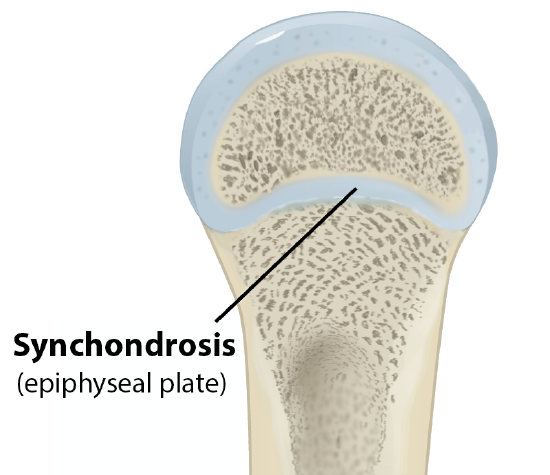
Growing layers of cartilage also form synchondroses that join together the ilium, ischium, and pubic portions of the hip bone during childhood and adolescence. When body growth stops, the cartilage disappears and is replaced by bone, forming synostoses and fusing the bony components together into the single hip (coxal) bone of the adult. Similarly, synostoses unite the sacral vertebrae that fuse together to form the adult sacrum.
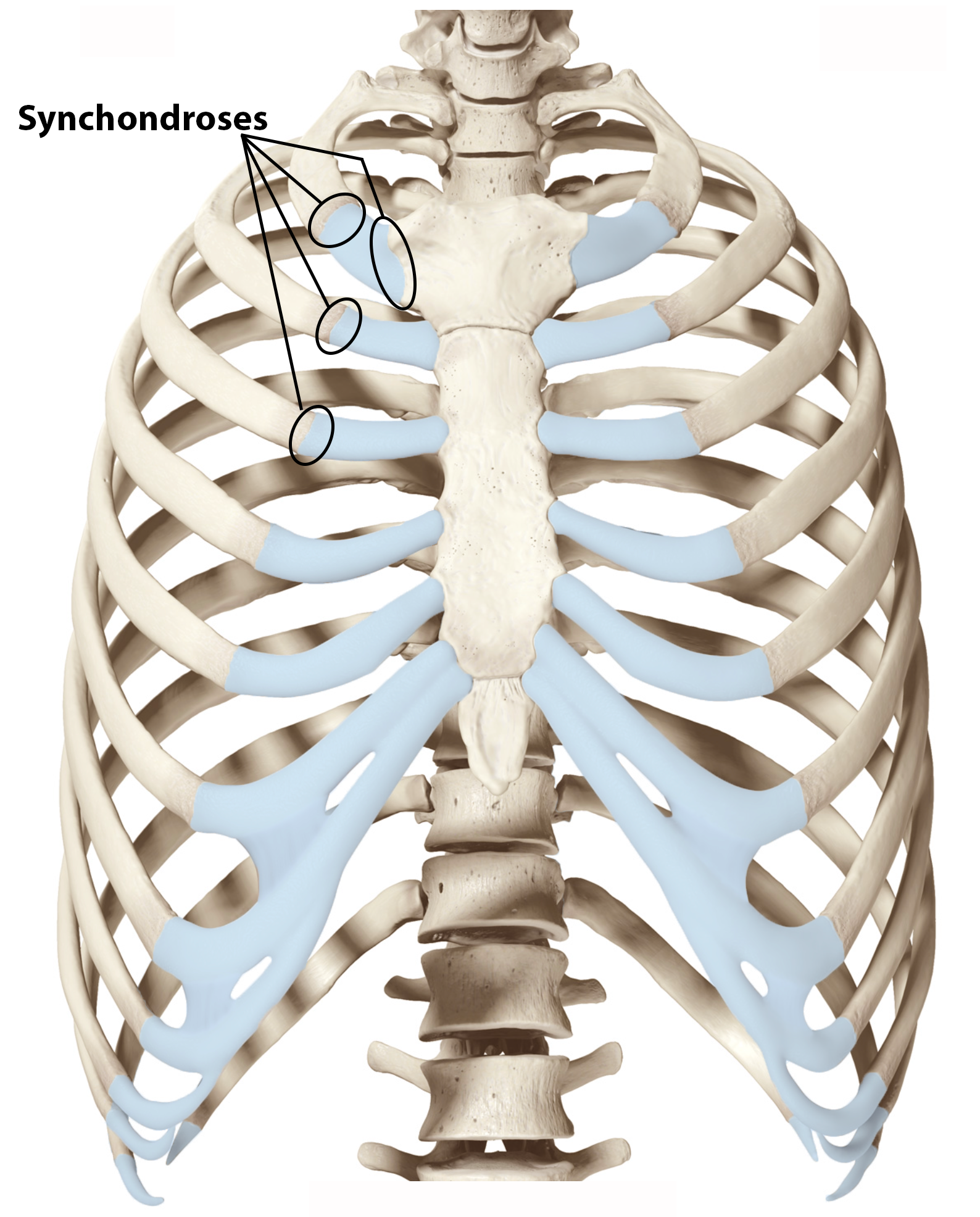
Examples of permanent synchondroses are found in the thoracic cage (Figure \(\PageIndex{6}\)). One example is the first sternocostal joint, where the first rib is anchored to the manubrium by its costal cartilage. (The articulations of the remaining costal cartilages to the sternum are all synovial joints.) Additional synchondroses are formed where the anterior end of the other 11 ribs is joined to its costal cartilage. Unlike the temporary synchondroses of the epiphyseal plate, these permanent synchondroses retain their hyaline cartilage and thus do not ossify with age. Due to the lack of movement between the bone and cartilage, both temporary and permanent synchondroses are functionally classified as a synarthrosis.
Symphysis
A cartilaginous joint where the bones are joined by fibrocartilage is called a symphysis (“growing together”). Fibrocartilage is very strong because it contains numerous bundles of thick collagen fibers, thus giving it a much greater ability to resist pulling and bending forces when compared with hyaline cartilage. This gives symphyses the ability to strongly unite the adjacent bones, but can still allow for limited movement to occur. Thus, a symphysis is functionally classified as an amphiarthrosis.
The gap separating the bones at a symphysis may be narrow or wide. Examples in which the gap between the bones is narrow include the pubic symphysis and the manubriosternal joint. At the pubic symphysis, the pubic portions of the right and left hip bones of the pelvis are joined together by fibrocartilage across a narrow gap. Similarly, at the manubriosternal joint, fibrocartilage unites the manubrium and body portions of the sternum. The intervertebral discs have a wider gap between the bones, and the fibrocartilage here is thicker to absorb compression from our body's weight (Figure \(\PageIndex{7}\)).
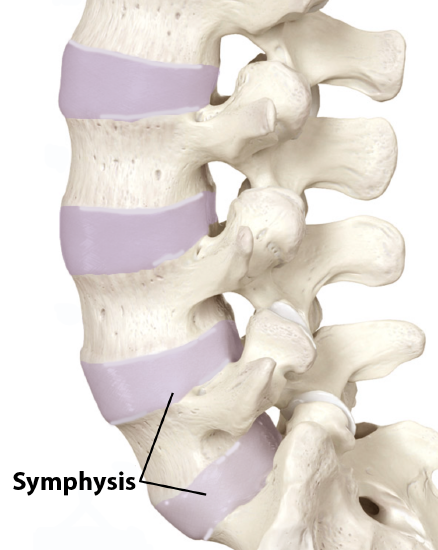
The intervertebral symphysis is a wide symphysis located between the bodies of adjacent vertebrae of the vertebral column. Here, a thick pad of fibrocartilage called an intervertebral disc strongly unites the adjacent vertebrae by filling the gap between them. The width of the intervertebral symphysis is important because it allows for small movements between the adjacent vertebrae. In addition, the thick intervertebral disc provides cushioning between the vertebrae, which is important when carrying heavy objects or during high-impact activities such as running or jumping.
Functional Classification of Joints
The functional classification of joints is determined by the amount of mobility found between the adjacent bones. The amount of movement available at a particular joint of the body is related to the functional requirements for that joint. Thus immobile or slightly moveable joints serve to protect internal organs, give stability to the body, and allow for limited body movement. In contrast, freely moveable joints allow for much more extensive movements of the body and limbs. Joints are thus functionally classified as
- a synarthrosis or immobile joint,
- an amphiarthrosis or slightly moveable joint, or
- a diarthrosis, which is a freely moveable joint.
Depending on their location, fibrous joints may be functionally classified as a synarthrosis or an amphiarthrosis. Cartilaginous joints are also functionally classified as either a synarthrosis or an amphiarthrosis joint. All synovial joints are functionally classified as a diarthrosis joint.
Synarthrosis
An immobile or nearly immobile joint is called a synarthrosis. The immobile nature of these joints provides for a strong union between the articulating bones. This is important at locations where the bones provide protection for internal organs. Examples include sutures, such as the coronal, squamous, and lambdoid sutures, which are the fibrous joints between the bones of the skull, and the manubriosternal joint (Figure \(\PageIndex{8}\)) that unites the manubrium and body of the sternum for protection of the heart.
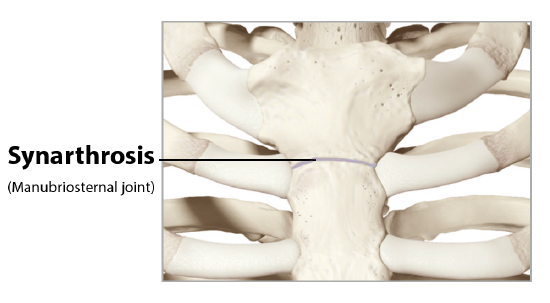
Amphiarthrosis
An amphiarthrosis is a joint that has limited mobility but slight movement is available in many directions. An example of this type of joint is the cartilaginous joint that unites the bodies of adjacent vertebrae. Filling the gap between the vertebrae is a thick pad of fibrocartilage called an intervertebral disc. Each intervertebral disc strongly unites the vertebrae but still allows for a limited amount of movement between them. However, the small movements available between adjacent vertebrae can sum together along the length of the vertebral column to provide for large ranges of body movements.
Another example of an amphiarthrosis is the pubic symphysis of the pelvis (Figure \(\PageIndex{9}\)). This is a cartilaginous joint in which the pubic regions of the right and left hip bones are strongly anchored to each other by fibrocartilage. This joint normally has very little mobility because the strength of the pubic symphysis is important in conferring weight-bearing stability to the pelvis. During childbirth this joint loosens so the pelvis can shift to adjust to the fetus passing through the pelvic outlet. Following birth, the joint should tighten again.
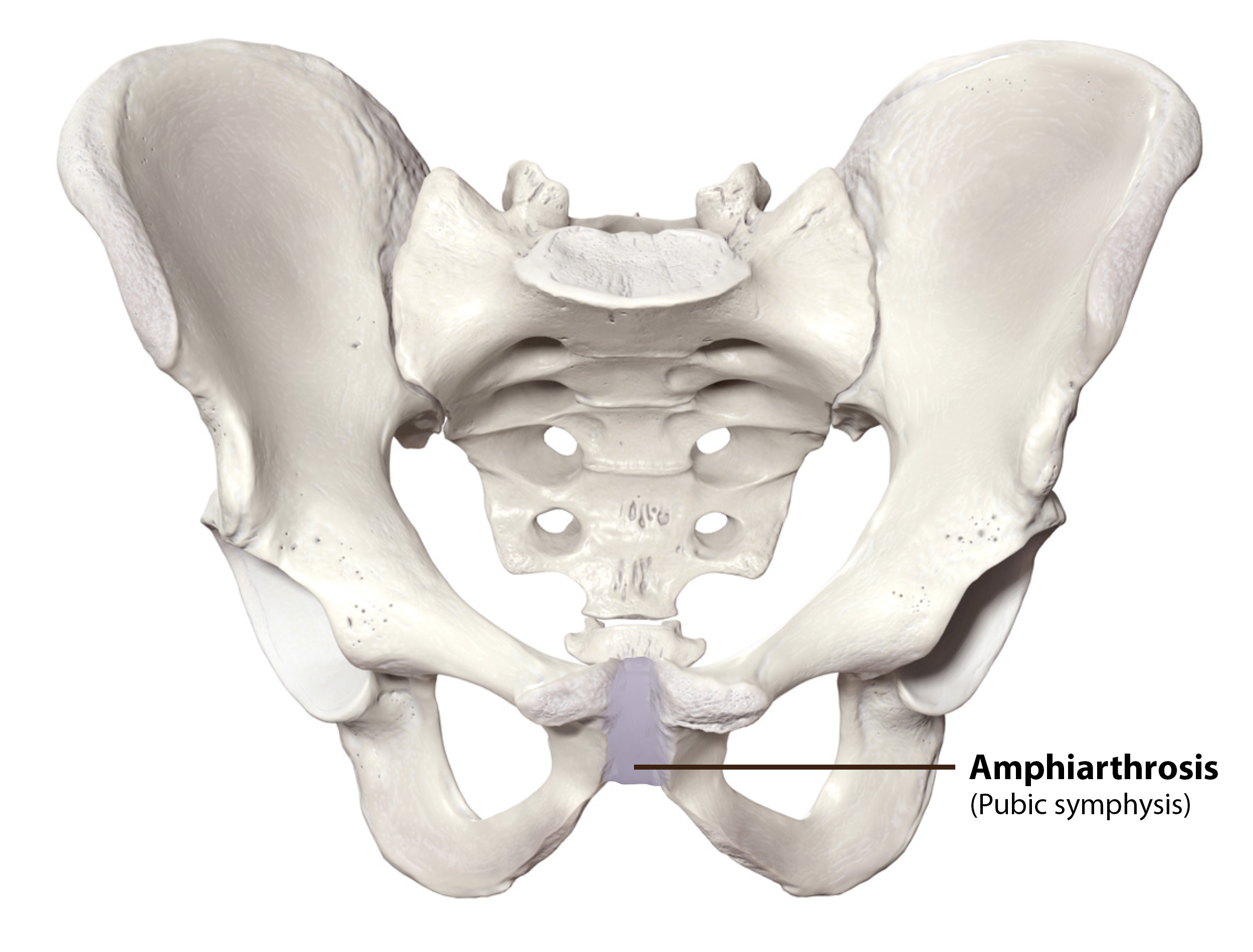
Diarthrosis
A freely mobile joint is classified as a diarthrosis. These types of joints include all synovial joints (structural classification) of the body, which provide the majority of body movements. Most diarthrotic joints are found in the appendicular skeleton and thus give the limbs a wide range of motion. These joints are divided into three categories, based on the number of axes of motion provided by each. An axis in anatomy is described as the movements in reference to the three anatomical planes: transverse, frontal, and sagittal. Thus, diarthroses are classified as uniaxial (for movement in one plane), biaxial (for movement in two planes), or multiaxial joints (for movement in all three anatomical planes).
- A uniaxial joint only allows for a motion in a single plane (around a single axis). The elbow joint, which only allows for bending or straightening, is an example of a uniaxial joint.
- A biaxial joint allows for motions within two planes. An example of a biaxial joint is a metacarpophalangeal joint (knuckle joint) of the hand. The joint allows for movement along one axis to produce bending or straightening of the finger, and movement along a second axis, which allows for spreading of the fingers away from each other and bringing them together.
- A joint that allows for the several directions of movement is called a multiaxial joint (polyaxial or triaxial joint). This type of diarthrotic joint allows for movement along three axes (Figure \(\PageIndex{10}\)). The hip joint, where the head of the femur articulates with the acetabulum of the hip bone, is a multiaxial joint. This allows the lower limb to move in an anterior-posterior direction and a medial-lateral direction. In addition, the limb can also be rotated around its long axis.
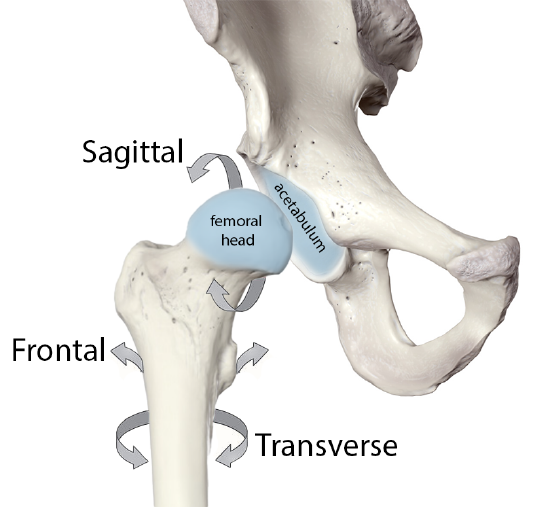
Concept Review
Structural classifications of the body joints are based on how the bones are held together and articulate with each other. At fibrous joints, the adjacent bones are directly united to each other by dense regular connective tissue. Similarly, at a cartilaginous joint, the adjacent bones are united by cartilage. In contrast, at a synovial joint, the articulating bone surfaces are not directly united to each other, but come together within a fluid-filled joint cavity.
There are two types of cartilaginous joints.
- A synchondrosis is formed when the adjacent bones are united by hyaline cartilage.
- Examples of synchondroses are: the epiphyseal plate of a growing long bone, the first sternocostal joint, and between the anterior ends of the bony ribs and the junction with their costal cartilage.
- A symphysis is where the bones are joined by fibrocartilage.
- A narrow symphysis is found at the manubriosternal joint and at the pubic symphysis.
- A wide symphysis is the intervertebral symphysis in which the bodies of adjacent vertebrae are united by an intervertebral disc.
The three types of fibrous joints are sutures, gomphoses, and syndesmoses.
- A suture is the narrow fibrous joint that unites most bones of the skull.
- At a gomphosis, the root of a tooth is anchored across a narrow gap by periodontal ligament to the walls of its socket in the bony jaw.
- A syndesmosis is the type of fibrous joint found between parallel bones. The gap between the bones may be wide and filled with a fibrous interosseous membrane, or it may narrow with ligaments spanning between the bones.
- Syndesmoses are found between the bones of the forearm (radius and ulna) and the leg (tibia and fibula).
The functional classification of body joints is based on the degree of movement found at each joint.
- A synarthrosis is a joint that is essentially immobile.
- Examples include the fibrous joints of the skull sutures and the cartilaginous manubriosternal joint.
- A joint that allows for limited movement is an amphiarthrosis.
- An example is the pubic symphysis of the pelvis, the cartilaginous joint that strongly unites the right and left hip bones of the pelvis.
- The cartilaginous joints in which vertebrae are united by intervertebral discs provide for small movements between the adjacent vertebrae and are also an amphiarthrosis type of joint.
The most common type of joint is the diarthrosis, which is a freely moveable joint. All synovial joints are functionally classified as diarthroses.
- A uniaxial diarthrosis, such as the elbow, is a joint that only allows for movement within a single anatomical plane.
- Joints that allow for movements in two planes are biaxial joints, such as the metacarpophalangeal joints of the fingers.
- A multiaxial joint, such as the shoulder or hip joint, allows for three planes of motions.
Review Questions
Q. The joint between adjacent vertebrae that includes an intervertebral disc is classified as which type of joint?
A. diarthrosis
B. multiaxial
C. amphiarthrosis
D. synarthrosis
- Answer
-
Answer: C
Q. Which of these joints is classified as a synarthrosis?
A. the pubic symphysis
B. the manubriosternal joint
C. an invertebral disc
D. the shoulder joint
- Answer
-
Answer: B
Q. Which of these joints is classified as a biaxial diarthrosis?
A. the metacarpophalangeal joint
B. the hip joint
C. the elbow joint
D. the pubic symphysis
- Answer
-
Answer: A
Q. Synovial joints ________.
A. may be functionally classified as a synarthrosis
B. are joints where the bones are connected to each other by hyaline cartilage
C. may be functionally classified as a amphiarthrosis
D. are joints where the bones articulate with each other within a fluid-filled joint cavity
- Answer
-
Answer: D
Q. Which type of fibrous joint connects the tibia and fibula?
A. syndesmosis
B. symphysis
C. suture
D. gomphosis
- Answer
-
Answer: A
Q. An example of a wide fibrous joint is ________.
A. the interosseous membrane of the forearm
B. a gomphosis
C. a suture joint
D. a synostosis
- Answer
-
Answer: A
Q. A gomphosis ________.
A. is formed by an interosseous membrane
B. connects the tibia and fibula bones of the leg
C . contains a joint cavity
D. anchors a tooth to the jaw
- Answer
-
Answer: D
Q. A syndesmosis is ________.
A. a narrow fibrous joint
B. the type of joint that unites bones of the skull
C. a fibrous joint that unites parallel bones
D. the type of joint that anchors the teeth in the jaws
- Answer
-
Answer: C
Q. A cartilaginous joint ________.
A. has a joint cavity
B. is called a symphysis when the bones are united by fibrocartilage
C. anchors the teeth to the jaws
D. is formed by a wide sheet of fibrous connective tissue
Answer
Answer: B
Q. The epiphyseal plate of a growing long bone in a child is classified as a ________.
A. synchondrosis
B. synostosis
C. symphysis
D. syndesmosis
- Answer
-
Answer: A
Q. Which of the following are joined by a symphysis?
A. adjacent vertebrae
B. the first rib and the sternum
C . the end and shaft of a long bone
D. the radius and ulna bones
- Answer
-
Answer: A
Q. A synchondrosis is ________.
A. found at the pubic symphysis
B. where bones are connected together with fibrocartilage
C. a type of fibrous joint
D. found at the first sternocostal joint of the thoracic cage
- Answer
-
Answer: D
Critical Thinking Questions
Q. The periodontal ligaments are made of collagen fibers and are responsible for connecting the roots of the teeth to the jaws. Describe how scurvy, a disease that inhibits collagen production, can affect the teeth.
- Answer
-
A. The teeth are anchored into their sockets within the bony jaws by the periodontal ligaments. This is a gomphosis type of fibrous joint. In scurvy, collagen production is inhibited and the periodontal ligaments become weak. This will cause the teeth to become loose or even to fall out.
Q. Define how joints are classified based on function. Describe and give an example for each functional type of joint.
- Answer
-
A. Functional classification of joints is based on the degree of mobility exhibited by the joint. A synarthrosis is an immobile or nearly immobile joint. An example is the manubriosternal joint or the joints between the skull bones surrounding the brain. An amphiarthrosis is a slightly moveable joint, such as the pubic symphysis or an intervertebral cartilaginous joint. A diarthrosis is a freely moveable joint. These are subdivided into three categories. A uniaxial diarthrosis allows movement within a single anatomical plane or axis of motion. The elbow joint is an example. A biaxial diarthrosis, such as the metacarpophalangeal joint, allows for movement along two planes or axes. The hip and shoulder joints are examples of a multiaxial diarthrosis. These allow movements along three planes or axes.
Q. Explain the reasons for why joints differ in their degree of mobility.
- Answer
-
A. The functional needs of joints vary and thus joints differ in their degree of mobility. A synarthrosis, which is an immobile joint, serves to strongly connect bones thus protecting internal organs such as the heart or brain. A slightly moveable amphiarthrosis provides for small movements, which in the vertebral column can add together to yield a much larger overall movement. The freedom of movement provided by a diarthrosis can allow for large movements, such as is seen with most joints of the limbs.
Q. Describe the two types of cartilaginous joints and give examples of each.
- Answer
-
A. Cartilaginous joints are where the adjacent bones are joined by cartilage. At a synchondrosis, the bones are united by hyaline cartilage. The epiphyseal plate of growing long bones and the first sternocostal joint that unites the first rib to the sternum are examples of synchondroses. At a symphysis, the bones are joined by fibrocartilage, which is strong and flexible. Symphysis joints include the intervertebral symphysis between adjacent vertebrae and the pubic symphysis that joins the pubic portions of the right and left hip bones.
Q. Both functional and structural classifications can be used to describe an individual joint. Define the first sternocostal joint and the pubic symphysis using both functional and structural characteristics.
- Answer
-
A. The first sternocostal joint is a synchondrosis type of cartilaginous joint in which hyaline cartilage unites the first rib to the manubrium of the sternum. This forms an immobile (synarthrosis) type of joint. The pubic symphysis is a slightly mobile (amphiarthrosis) cartilaginous joint, where the pubic portions of the right and left hip bones are united by fibrocartilage, thus forming a symphysis.
Glossary
- amphiarthrosis
- slightly mobile joint
- articulation
- joint of the body
- biaxial joint
- type of diarthrosis; a joint that allows for movements within two planes (two axes)
- cartilaginous joint
- joint at which the bones are united by hyaline cartilage (synchondrosis) or fibrocartilage (symphysis)
- diarthrosis
- freely mobile joint
- fibrous joint
- joint where the articulating areas of the adjacent bones are connected by fibrous connective tissue
- fontanelles
- expanded areas of fibrous connective tissue that separate the braincase bones of the skull prior to birth and during the first year after birth
- gomphosis
- type of fibrous joint in which the root of a tooth is anchored into its bony jaw socket by strong periodontal ligaments
- interosseous membrane
- wide sheet of fibrous connective tissue that fills the gap between two parallel bones, forming a syndesmosis; found between the radius and ulna of the forearm and between the tibia and fibula of the leg
- joint
- site at which two or more bones or bone and cartilage come together (articulate)
- joint cavity
- space enclosed by the articular capsule of a synovial joint that is filled with synovial fluid and contains the articulating surfaces of the adjacent bones
- ligament
- strong band of dense connective tissue spanning between bones
- multiaxial joint
- type of diarthrosis; a joint that allows for movements within three planes (three axes)
- periodontal ligament
- band of dense connective tissue that anchors the root of a tooth into the bony jaw socket
- suture
- fibrous joint that connects the bones of the skull (except the mandible); an immobile joint (synarthrosis)
- symphysis
- type of cartilaginous joint where the bones are joined by fibrocartilage
- synarthrosis
- immobile or nearly immobile joint
- synchondrosis
- type of cartilaginous joint where the bones are joined by hyaline cartilage
- syndesmosis
- type of fibrous joint in which two separated, parallel bones are connected by an interosseous membrane
- synostosis
- site at which adjacent bones or bony components have fused together
- synovial joint
- joint at which the articulating surfaces of the bones are located within a joint cavity formed by an articular capsule
- uniaxial joint
- type of diarthrosis; joint that allows for motion within only one plane (one axis)
Contributors and Attributions
OpenStax Anatomy & Physiology (CC BY 4.0). Access for free at https://openstax.org/books/anatomy-and-physiology

